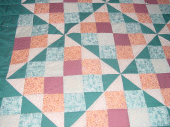|

No one can be certain where quilting originated, but it is believed that it originated in Israel and migrated across the Mediterranean to Europe. Quilts were created as protection against the cold, but this was not their only purpose. Many soldiers also used quilts for padding underneath their amour while in battle.
In the nineteenth century, everything was saved and re-used and clothing was no exception. Old clothing scraps were traditionally used in quilts because many families could not afford to buy the material needed. Quilts were stuffed with lamb's wool, moss, or feathers, depending on what was accessible.
Early quilts were made for warmth only and not for decoration. It is unknown when quilts became more decorative, but decorative quilts did not begin to emerge in the Maritimes until a permanent settlement had been established. At this time, scrolls and decorative motifs were added to the quilts to give them more detail.
Eventually, many social occasions became centered around quilting. If a local girl was engaged to be married, the women would hold a quilting bee for her. Quilting bees were not only for special occasions, but also a good way to pass the long cold winter.
Before a quilt could be started, the woman of the house would have to gather the fabric needed, press it, and cut it into the desired shapes. The separate pieces were pinned together, sewn, and pressed once again. The backing of the quilt was sewn into a wooden frame and the lamb's wool and quilt top were placed on and pinned. After this the women could begin quilting along the outside of the pattern in the quilt.
In the twenty- first century, the tradition of quilting is still alive and well in Sherbrooke Village where at least one quilt is made by our staff every season. However, old clothing is no longer used to make the quilts and lamb's wool, moss, or feathers are not used for the batting. Instead, new material for the quilt and cotton batting are used. Visitors are welcome to come and watch as the guides of the Village undertake the quilting process. Visitors are also welcome to come and view the quilts that are for sale in the Temperance Hall.
Click for more pictures

|

|
|